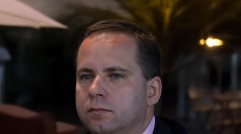'Star Wars: Episode 7 -- The Force Awakens' Spoilers, Analysis: Why Marginalizing Prequels Is a Bad Move
There is a disturbance in the force, a situation threatening to create a great rift in the "Star Wars" universe, one that will build on the schism of the last few years.
The name of this disturbance? "Episode VII -- The Force Awakens."
The film itself is not a reason for concern as a new "Star Wars" movie is undoubtedly a reason to celebrate for fans around the world. The problem is the way the marketing of the film has been handled, how it is increasingly becoming a divisive strategy, catering to a specific crop of fans while, possibly, unknowingly polarizing another group of fans within the franchise.
"Star Wars" has always been about conflict, the main films often pitting two sides against one another. The originals had the empire and rebels duke it out, while the prequels inverted things with the Republic and separatists engaging in galactic war.
The biggest war, however, is between fans. On one hand are fans of the originals who hate the prequel films made between 1999 and 2005. In the other camp are fans of all the films, including the prequels. For years these sides have duked it out on forums and online with one of the most publicized battles taking place in 2011 when Jim Raynor published a 108-page aggressive rebuttal to the famed Red Letter Media reviews for the prequel films. Red Letter Media's video reviews were rather scathing deconstructions of Episodes I, II and III and even gained notoriety after acquiring the support of major celebrities (more on that later). Disney must know about the conflict, and yet it seems intent on letting it fester and grow.
The Comic-Con panel for the film was known for bringing all the big actors in the film on stage for a big conversation. Then it showed a behind-the-scenes video that likely put prequel fans to the sword.
"Real sets, practical effects" are the two main lines that start off the teaser, while showing off a demo reel that supports these words. Throughout the teaser, this concept is harped on repeatedly (there was even an often-ridiculed explanation that the film was shot at a "real" desert), but one major aspect of "Star Wars" is completely left out: computer animation.
Since the release of the 1997 Special editions of the original trilogy and the subsequent prequel films, CGI has been among the major controversial points for fans the world over. "Prequel bashers" claim that the computer animations have taken away from the lifeblood of the franchise, while others see no issues. For the "prequel gushers," "Star Wars" has always been about implementing the latest state-of-the-art technology to tell stories of the galaxy far, far away. That includes not only practical effects, but also CGI.
So by completely ignoring computer animation in the teaser, the marketing team is in some ways ignoring the prequels and aiming to bring back fans who have grown hostile toward the "Star Wars" brand.
This in turn has created a hostile response from fans who do love the prequel films and feel disenfranchised by the recent marketing strategies.
Don't believe that prequel fans felt ignored by the marketing at Comic-Con? Here are links to two videos made parodying the "practical effects" and "real sets" lines. Moreover, fan sites have also come out blasting the strategy as hostile.
"What I've come to think, and what I've been arguing for the last few weeks, has been basically confirmed this weekend. Because as a Prequel-fan, this Comic-Con held a bitter realization," says an article in Clone Corridor, a fan site dedicated toward the prequel films.
"That realization is that the current marketing and PR strategy for 'The Force Awakens' is to subtly, or not so subtly, bash the Prequels in order to get 'Star Wars' naysayers and critics on the side of the new film and new trilogy... Apart from the fact that I feel this will end up being bad for business in the future, it is currently bad for the fandom because it plays into a perception of the 'Star Wars' fandom which is incorrect."
Paul F. Donald, author of "The Star Wars Heresies," an intricate analysis of the prequel films, also posted a similar sentiment on his blog "Star Wars Heresies."
Some might argue this is mere speculation on the part of disgruntled fans, but Disney's decision to include known prequel critics in the marketing and the film itself has not helped.
Simon Pegg has been known for crusading against the prequel films for years. He even championed the controversial video reviews (or more appropriately attacks) on the prequel films by Red Letter Media. Showing him as a part of the new film only serves to add fuel to the fire for prequel fans that feel that the company is looking to distance itself from the prequels.
Even director J.J. Abrams is not above reproach as his selection brings in a major fan of the originals whose comments regarding the prequels have been controversial. He once stated that he "thought about putting Jar Jar Binks's bones in the desert there...I'm serious! Only three people will notice, but they'll love it." This is undoubtedly a direct assault on one of the most controversial and reviled prequel characters but one that prequel fans staunchly defend. He also recently stated in an interview that midichlorians, the micro-organism that allow a Jedi to communicate with the force (they are often misinterpreted as being the force itself) would not be referenced at all in the film. The latter point is not a big issue as the original trilogy makes no mention of them, and the Jar Jar comment was likely a joke. However, these comments certainly add more ammunition to the disenfranchised prequel fans who see every comment against those films as another reason to remain reticent toward any incursions from filmmakers and producers not named George Lucas.
Of course Abrams has yet to go as far as claim the prequels are not part of the canon as a recent Yahoo article indicated, and he even stated his children were big fans of the films. However, he has never come out and made mention of linking those films with his new project. He does not have to, but it certainly would help to have a director that serves as a unifying force for both sides of the spectrum rather than one that could further the schism in the fandom.
The problem is marginalizing the prequels could tarnish the legacy of Disney's own films. Generations that grew up on the prequels are slowly but surely finding their voices online and in literature. The prequels, who have for so long become whipping boys of older "Star Wars," have actually gotten better critical appreciation over the years from fans and scholars alike.
Anne Lancashire, renowned English professor at the University of Toronto, wrote two famous essays on the political value of "Attack of the Clones" and an intricate analysis on the repetition in "The Phantom Menace." Donald's "Star Wars Heresies," analyzed the prequels and their literary roots. Mike Klimo, a fan of the franchise, recently published his famed "Star Wars Ring Theory" in 2014, arguing for the prequels enhancing the original trilogy by making the two sets of films direct mirror images of that inform and elucidate one another. Bright Lights Film Journal also published an article in 2002 that defended the second prequel film as sophisticated. Dr. Camille Paglia, University of Arts professor at Yale, even dedicated an entire piece to George Lucas being the greatest modern artist and spent a substantial amount of time praising "Episode III -- Revenge of the Sith."
Many of these scholars and writers will be brought together by the Ministry of Cinema in the upcoming "The Prequels Strike Back," a crowd-funded documentary that seeks to defend the often-maligned films.
It seems that these are not films that can be easily shunned any longer and doing so could further alienate Disney from a large part of the fan base. Attacking them might serve to alienate fans from the newer pictures, thus augmenting the rift in the franchise and even pitting Disney as the villain.
Ultimately this is "Star Wars," the biggest franchise in the history of franchises and one that is likely to register money regardless of the criticism or controversy. This of course is Disney's modus operandi. Conflict leads to controversy. Controversy leads to more press. More press leads to a big box office. To the tune of $2.2 billion worldwide if recent estimations are to be believed. This is Disney's ultimate end game. Recouping and building on the $4 billion it spent to buy Lucas' franchise.
More importantly by the time 2020 rolls around, Disney will have as many Star Wars movies to its credit as George Lucas did between 1977 and 2005. In 2021, the company will have made more Star Wars films than the creator himself. At that point who owns "Star Wars?"
Disney of course, but the fans and their attitude toward the company may be just as important toward the franchise's long-term welfare.
Subscribe to Latin Post!
Sign up for our free newsletter for the Latest coverage!










